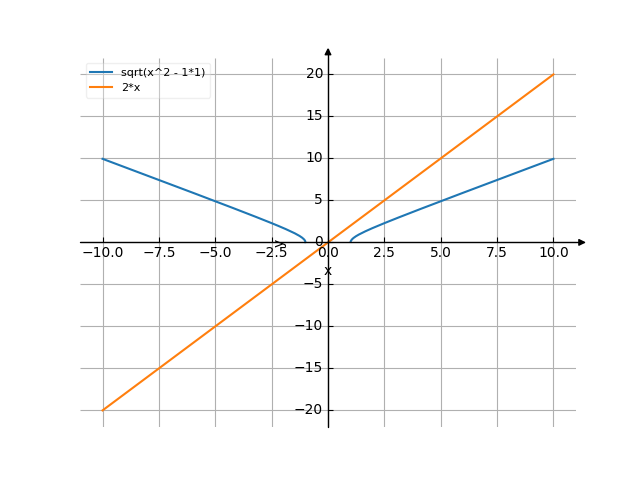√(x^2-1)=2*x equation
The teacher will be very surprised to see your correct solution 😉
The solution
Detail solution
Given the equation
$$\sqrt{x^{2} - 1} = 2 x$$
$$\sqrt{x^{2} - 1} = 2 x$$
We raise the equation sides to 2-th degree
$$x^{2} - 1 = 4 x^{2}$$
$$x^{2} - 1 = 4 x^{2}$$
Transfer the right side of the equation left part with negative sign
$$- 3 x^{2} - 1 = 0$$
This equation is of the form
A quadratic equation can be solved
using the discriminant.
The roots of the quadratic equation:
$$x_{1} = \frac{\sqrt{D} - b}{2 a}$$
$$x_{2} = \frac{- \sqrt{D} - b}{2 a}$$
where D = b^2 - 4*a*c - it is the discriminant.
Because
$$a = -3$$
$$b = 0$$
$$c = -1$$
, then
Because D<0, then the equation
has no real roots,
but complex roots is exists.
or
$$x_{1} = - \frac{\sqrt{3} i}{3}$$
Simplify
$$x_{2} = \frac{\sqrt{3} i}{3}$$
Simplify
$$\sqrt{x^{2} - 1} = 2 x$$
$$\sqrt{x^{2} - 1} = 2 x$$
We raise the equation sides to 2-th degree
$$x^{2} - 1 = 4 x^{2}$$
$$x^{2} - 1 = 4 x^{2}$$
Transfer the right side of the equation left part with negative sign
$$- 3 x^{2} - 1 = 0$$
This equation is of the form
a*x^2 + b*x + c = 0
A quadratic equation can be solved
using the discriminant.
The roots of the quadratic equation:
$$x_{1} = \frac{\sqrt{D} - b}{2 a}$$
$$x_{2} = \frac{- \sqrt{D} - b}{2 a}$$
where D = b^2 - 4*a*c - it is the discriminant.
Because
$$a = -3$$
$$b = 0$$
$$c = -1$$
, then
D = b^2 - 4 * a * c =
(0)^2 - 4 * (-3) * (-1) = -12
Because D<0, then the equation
has no real roots,
but complex roots is exists.
x1 = (-b + sqrt(D)) / (2*a)
x2 = (-b - sqrt(D)) / (2*a)
or
$$x_{1} = - \frac{\sqrt{3} i}{3}$$
Simplify
$$x_{2} = \frac{\sqrt{3} i}{3}$$
Simplify
Sum and product of roots
[src]
sum
___
I*\/ 3
0 + -------
3
$$0 + \frac{\sqrt{3} i}{3}$$
=
___ I*\/ 3 ------- 3
$$\frac{\sqrt{3} i}{3}$$
product
___
I*\/ 3
1*-------
3
$$1 \frac{\sqrt{3} i}{3}$$
=
___ I*\/ 3 ------- 3
$$\frac{\sqrt{3} i}{3}$$
i*sqrt(3)/3
Numerical answer
[src]
x1 = 3.14703168507791e-35 + 0.577350269189626*i
x1 = 3.14703168507791e-35 + 0.577350269189626*i
The graph


![Solve the equation √(x²-1)=2*x (√(x squared minus 1) equally 2 multiply by x) - Find the roots of the equation in detail step by step. [THERE'S THE ANSWER!] √(x^2-1)=2*x](/media/krcore-image-pods/176/hash/equation/d/67/e48c082867107cd498aff50c8ae56.png)
 Equation √(x^2-1)=2*x
Equation √(x^2-1)=2*x
 Equation tan(x)=4
Equation tan(x)=4
 Equation 2*cos(x)/2=1+cos(x)
Equation 2*cos(x)/2=1+cos(x)
 Equation 2x^2-x-1=x^2-5x-(-1-x^2)
Equation 2x^2-x-1=x^2-5x-(-1-x^2)
 √(x^2-1)
√(x^2-1)
 2*x
2*x
 √(x^2-1)
√(x^2-1)
 2*x
2*x
 2*x
2*x